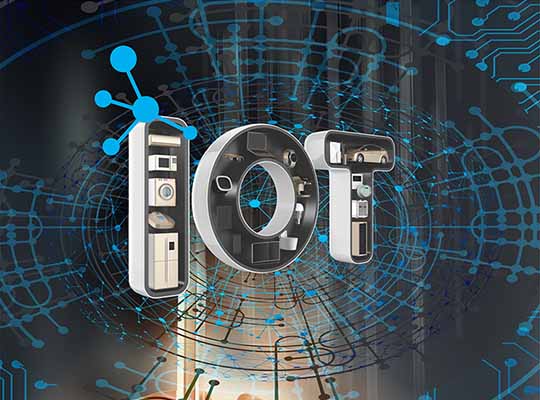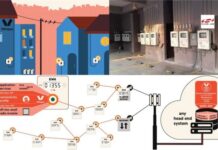The Internet of Things (IoT) is a broad term that refers to a huge array of “things” that are linked to the internet to exchange data with other objects — IoT apps, connected devices, industrial machinery, and so on. Built-in sensors enable internet-connected gadgets to gather data and, in some situations, act on it. IoT-connected gadgets and equipment have the potential to significantly change how we work and live. Examples of real-world Internet of Things applications vary from a smart house that automatically changes the temperature and lighting to a smart factory that monitors industrial machinery for faults and then adapts automatically to prevent failures.
The internet of things, or IoT, is a network of interconnected computing devices, mechanical and digital machinery, items, animals, and people with unique identities (UIDs) and the capacity to send data over a network without needing human-to-human or human-to-computer contact.
“We may use the Internet of Things (IoT) to understand the context (the customer’s time and location) and reply promptly when we are convinced the client needs assistance or an enticement to spend.”
People with heart monitors, farm animals with biochip transponders, cars with sensors that notify drivers of low tire pressure, or any other natural or man-made item having an IP address and the ability to send data across a network are all examples of objects on the internet of things.
Increasingly, businesses across sectors are adopting IoT to improve efficiency, better understand consumers, make better decisions, and generate corporate value.
How does IoT work?
An IoT ecosystem comprises web-enabled smart devices that gather, communicate, and act on data from their environs. IoT devices link to an IoT gateway or other edge device to exchange sensor data that is either routed to the cloud for analysis or examined locally. These gadgets may interact with one another and act on the information they receive. People may engage with the gadgets to set them up, give them instructions, or access data, but they conduct most of the work alone.
The IoT applications implemented determine the connection, networking, and communication protocols employed.
IoT can utilize AI and machine learning to make data collection simpler and more dynamic.
History of the Internet of Things
Entrepreneur Kevin Ashton, one of the founders of MIT’s Auto-ID Center, developed the phrase “Internet of Things.” Ashton was part of a team that used how an RFID tag to connect devices to the internet. In a 1999 lecture, he coined the term “Internet of Things,” which has been with him ever since.
Although Ashton coined the phrase “Internet of Things,” the notion of linked objects, especially networked machines, has been around for quite some time. Machines, for example, have been talking with one another since the late 1830s, when the first electric telegraphs were constructed. Radio voice communications, wireless (Wi-Fi) technology, and supervisory control and data acquisition (SCADA) software were among the other technologies that flowed into IoT. The first linked smart appliance was a customized Coke machine at Carnegie Mellon University in 1982. Students could check which beverages were supplied and if they were cold using the university’s local ethernet or ARPANET – a predecessor to today’s internet.
We now live in a world where there are more linked IoT devices than people. Wearables from smartwatches to RFID inventory tracking chips are among the IoT-linked gadgets and equipment. Networks or cloud-based systems linked to the Internet of Things allow connected objects to interact. Digital transformation is fueled by real-time insights gathered from IoT data. Many good changes are expected because of the Internet of Things, including improvements in health and safety, company operations, industrial performance, and worldwide environmental and humanitarian challenges.
Who’s Using IoT?
As part of their digital transformation initiatives, several sectors utilize IoT to better understand customer expectations, increase machine and system quality, simplify operations, and develop new ways to perform.
Retail: IoT connects data, analytics, and marketing processes. Retailers use IoT data from in-store and digital channels to identify customer behavior trends and preferences. Their IoT approach frequently includes RFID inventory monitoring chips, cellular and Wi-Fi networks, beacons, and smart shelves.
Manufacturing: For a realistic perspective of production, process, and product data, IoT integrates all stages of the Industrial Internet of Things (IIoT) process. Big data analytics and predictive modeling combined with advanced IoT sensors in manufacturing machines and warehouse shelves can reduce faults, increase production output, reduce warranty costs, and improve customer experience.
Health Care: The Internet of Medical Things (IoMT) collects real-time data from wearables and other medical-linked devices that track exercise, sleep, and other health routines. This IoT data enhances the safety of patients and results while streamlining patient care.
Transportation and Logistics: Transport and logistics organizations may benefit from IoT with geofence-enabled location information and AI implemented throughout the value chain. That means better service, less downtime, and happier customers. Manage, track, and monitor linked cars, freight, and other mobile assets in real-time to improve safety and minimize expenses.
Government: Traffic congestion, municipal services, economic growth, citizen involvement, and public safety and security are all addressed by IoT applications. Streetlights, water meters, and traffic signals are common examples of IoT sensors in smart cities.
Energy: The IoT helps suppliers offer dependable, fair-priced services. IoT-enabled machinery and gadgets anticipate issues. IoT integrates distributed grid resources like solar and wind. And behavioral data from smart homes help build personalized services and increase convenience and security.
IoT Market Maturity
Since 2012, significant sensor advancements have resulted in a quick maturation of the Internet of Things sector, enabling digital transformation for many enterprises:
Sensors shrank: Technological advancements resulted in minuscule size sensors, which led to innovations such as microelectromechanical systems (MEMS). This reduced the size of sensors, allowing them to be installed in unusual areas such as clothes.
Communications improved: Wireless internet connection and communication technology have advanced to the point that almost any form of electronic device may now offer wireless data access. This enables IoT sensors installed on Internet of Things-connected devices and equipment to transmit and receive IoT data via a network in real-time.
Key Technologies and IoT
Management of data and analytics in real-time: The Internet of Things places great demands on data management to handle large amounts of data pouring from sensors. Event stream processing technology, also known as streaming analytics, conducts real-time data management and analytics on IoT data to increase its value. Filtering, normalization, standardization, transformation, aggregation, correlation, and temporal analysis are all important skills.
Analytics based on big data: The Internet of Things is a significant contributor to big data – the huge amount, velocity, and diversity of structured and unstructured data collected by enterprises each day. To get value from large data in the IoT, big data analytics is required. Predictive analytics, text mining, cloud computing, data mining, data lakes, and Hadoop are all related approaches. Most firms use a mix of these strategies to maximize the value of IoT.
Artificial intelligence (AI): By facilitating learning and collective intelligence via the utilization of all data from smart connected devices, artificial intelligence has the potential to quadruple the value of IoT. Machine learning, deep learning, natural language processing, and computer vision are only a handful of the basic techniques used by AI.
What are the advantages of IoT for businesses?
The IoT has several advantages for businesses. Some advantages are industry-specific, while others are cross-industry. Common IoT advantages include:
- keep track of their whole company procedures.
- enhance the customer experience (CX).
- save both time and money
- increase staff productivity.
- integrating and modifying business models
- make more informed business choices; and
- earn more income.
Pros and cons of IoT
Several of the benefits of the Internet of Things include the following:
- the capacity to access the data from any location and on any device at any time.
- enhanced communication between linked electronic devices.
- data packet transport through a connected network, saving time and money; and
- automating activities that contribute to the improvement of a business’s service quality and reduce the need for human involvement.
IoT standards and frameworks
There are various evolving standards for the Internet of Things, including the following:
- IPv6 The Internet Engineering Task Force established Low-Power Wireless Personal Area Networks (6LoWPAN) is an open standard (IETF). The 6LoWPAN standard allows any low-power radio, such as 804.15.4, Bluetooth Low Energy (BLE), and Z-Wave, to interact with the internet (for home automation).
- ZigBee is a limited, low-speed wireless network that is mostly utilized in industrial environments. ZigBee is based on the IEEE 802.15.4 standard. The ZigBee Alliance developed Dotdot, an IoT universal language that allows smart things to communicate safely and comprehend one another over any network.
- LiteOS is a wireless sensor network operating system (OS) based on Unix. LiteOS is compatible with smartphones, wearables, intelligent manufacturing applications, smart homes, and vehicles connected to the internet (IoT). Additionally, the OS acts as a development platform for smart devices.
- OneM2M is a software-based and hardware-based machine-to-machine service layer that enables the connection of devices. OneM2M, a worldwide standards organization, was founded to produce reusable standards that allow IoT applications across several industries to interact.
- The Object Management Group (OMG) established the Data Distribution Service (DDS), an Internet of Things (IoT) standard for real-time, scalable, and high-performance M2M connectivity.
- The Advanced Message Queuing Protocol (AMQP) is a freely available open-source standard for asynchronous messaging over the Internet. AMQP allows organizations and applications to communicate securely and interoperate. The protocol is used in client-server communications and the control of Internet of Things devices.
- The Internet Engineering Task Force (IETF) developed the Constrained Application Protocol (CoAP), which defines how low-power, compute-constrained devices may function on the internet of things.
- This is an example of a protocol for WANs called Long Range Wide Area Network (LoRaWAN). It is designed to be used with huge networks, like smart cities, which have a lot of low-power devices.
IoT security and privacy issues
The internet of things contains billions of devices and billions of data points, all of which must be safeguarded. IoT security and privacy are major concerns due to the increased attack surface.
In 2016, Mirai, a botnet that infiltrated domain name server provider Dyn, took down many websites for an extended time in one of the largest DDoS attacks ever seen. Attackers gained network access by exploiting insecure IoT devices.
Because IoT devices are so interconnected, a hacker only must exploit one flaw to corrupt all data. Manufacturers that fail to update their equipment periodically expose them to hackers.
Also, many linked gadgets ask for personal information like names, ages, addresses, phone numbers, and even social media accounts, which hackers love.
Hackers are not the only danger to the internet of things; consumers’ privacy is also a key problem. For example, corporations that manufacture and distribute consumer IoT devices may utilize such devices to collect and sell user data.
Worldwide IoT expenditure is expected to exceed $745 billion in 2019, up 15.4 percent from $646 billion in 2018, and surpass $1 trillion in 2022, according to IDC.
Discrete manufacturing ($119 billion in investment), process manufacturing ($78 billion), transportation ($71 billion), and utilities ($61 billion) were anticipated to be the top IoT sectors. For manufacturing, asset management initiatives will be critical; for transportation, freight tracking and fleet management will take precedence. The utilities industry’s IoT expenditure will be driven by smart-grid initiatives for electricity, natural gas, and water.
Consumer IoT investment is expected to reach $108 billion, making it the second biggest industry category; most of the spending will go into smart homes, personal wellness, and linked car entertainment.
Manufacturing operations ($100 billion), production asset management ($44.2 billion), smart home ($44.1 billion), and freight monitoring ($41.7 billion) will be the most heavily invested in use cases.
What is the Industrial Internet of Things (IIoT)?
The Industrial Internet of Things (IIoT), the fourth industrial revolution, or Industry 4.0 is various terms used to describe the use of IoT technology in business. The idea is like that of consumer IoT devices in the house, but the objective is to analyze and optimize industrial processes via the use of sensors, wireless networks, big data, artificial intelligence, and analytics.
If implemented throughout a full supply chain, rather than simply individual enterprises, the effect might be higher, since just-in-time material delivery and production management from start to finish are possible. While increasing workforce productivity and cost savings are two objectives, the IIoT can also help businesses generate new revenue streams; rather than just selling a standalone product – say, an engine – manufacturers can also sell predictive maintenance for the engine.
IoT and cyberwarfare
The Internet of Things (IoT) transforms computation into a physical reality. As a result, if anything goes wrong with IoT devices, there may be significant real-world ramifications – something that governments considering their cyberwarfare plans are increasingly considering.
Briefings from the US intelligence community have warned that enemies already possess the capability to attack the country’s key infrastructure as well as “the larger ecosystem of linked consumer and industrial gadgets dubbed the Internet of Things.” Additionally, US intelligence has warned that connected thermostats, cameras, and cookers could all be used to spy on foreign citizens or to cause havoc if hacked. By incorporating crucial pieces of national critical infrastructure (such as dams, bridges, and components of the energy grid) into the IoT, it becomes even more necessary to maintain the highest level of security feasible.
How does the Internet of Things and 5G connect and share data?
IoT devices connect and interact data in a variety of ways, but the majority will do so wirelessly: homes and offices will use standard Wi-Fi, Zigbee, or Bluetooth Low Energy (or even Ethernet if they are not particularly mobile); other devices will communicate via LTE (existing technologies include Narrowband IoT and LTE-M, which are primarily aimed at small devices sending small amounts of data) or even satellite connections. However, given the breadth of available possibilities, some say that IoT communication protocols should be as widely acknowledged and interoperable as Wi-Fi is today.
Undoubtedly, one area of development in the next years will be the usage of 5G networks to assist IoT initiatives. 5G enables the deployment of up to one million 5G devices per square kilometer, which enables the usage of a huge number of sensors in a relatively small area, enabling large-scale industrial IoT deployments. The United Kingdom has recently begun a trial of 5G and the Internet of Things at two smart factories.’ However, it may be some years before major 5G installations occur: According to Ericsson, there will be over five billion IoT devices linked to cellular networks by 2025, but only about a quarter of those will be broadband IoT, with the bulk of those connected through 4G.
According to Gartner, outdoor security cameras will be the biggest market for 5G IoT devices in the short term, accounting for the majority (70 percent) of 5G IoT devices this year before declining to 30% by the end of 2023, when linked autos will surpass them.
According to the analyst firm, 3.5 million 5G IoT devices will be in use this year and fifty million by 2023. In the long run, it is anticipated, the automobile industry would be the biggest sector for 5G IoT use cases.
One tendency is that as the IoT matures, fewer data will be routed to the cloud for processing. To save expenses, more processing might be performed on-device, with only valuable data being transferred to the cloud — a concept known as ‘edge computing’. This will need the development of new technologies, such as tamper-resistant edge servers capable of collecting and analyzing data at locations far from the cloud or corporate data center.
IoT data and artificial intelligence
IoT devices create massive volumes of data; this data may include the temperature of an engine, the status of a door, or the reading from a smart meter. All this Internet of Things data must be gathered, stored, and analyzed. One-way businesses are using this data is by feeding it into artificial intelligence (AI) systems that process the IoT data and make predictions.
For instance, Google has delegated control of its data center cooling system to an AI. The AI collects data from hundreds of IoT devices and feeds it into deep neural networks, which forecast how various decisions will affect future energy use. Google has increased the efficiency of its data centers via the use of machine learning and artificial intelligence and said that the same technology might be used in other industrial settings.
IoT evolution: Where does the Internet of Things go next?
As even the cost of sensors and communications devices continues to fall, it becomes economically viable to connect more items to the IoT – even if there is no visible advantage to customers in certain circumstances. Deployments remain in their infancy; most businesses who are experimenting with the IoT are doing so now, primarily because the essential technology – sensor technology, 5G, and machine-learning-powered analytics – is still in its infancy. There are several competing platforms and standards, and numerous suppliers, ranging from device manufacturers to software vendors to network operators, all want a piece of the action. Which of them will prevail is yet unknown? However, without standards and with security being a concern, we are sure to witness some more high-profile IoT security failures in the coming years.
As the number of connected devices increases, our homes and workplaces will become more populated with smart items — if we are ready to accept the security and privacy trade-offs. Some will embrace the new age of intelligent objects. Others will yearn for the simpler times when a chair was just that: a chair.
From 2020 to 2025, the Indian internet of things (IoT) industry is predicted to develop at a compound annual growth rate of 13.2 percent.
The “Internet of Things” Boosts Agricultural Livelihoods in India
Improved connection in isolated locations is assisting farmers in increasing agricultural yields and enabling fishermen to travel out into the sea more securely.
The Internet of things (IoT)—sensors and software applications embedded in ordinary objects—has benefited rural communities and agriculture in India tremendously. However, connection and infrastructure remain a concern. Satellite-based networks may help bridge the connection divide in distant locations, but they can be costly due to the equipment needed by customers and providers.
Narrowband (NB)-IoT technology has the potential to help close the divide between inaccessible locations and the advantages of Internet connection. As the name indicates, NB-IoT operates on a single narrowband frequency (two hundred kilohertz), which restricts transmission speeds but enables simultaneous connection of a large number of users across a broad region. The technology is inexpensive for consumers and compatible with almost any mobile phone.
The fourth wave of the industrial revolution is all about digital empowerment and using new technologies and IT services across edge and cloud assets to increase productivity. These technologies range from sophisticated analytics to industrial IoT systems, artificial intelligence, and digital twins, all of which address critical demands in the manufacturing industry. The Internet of Things has exploded in popularity during the past several years. Globally, thirty-five billion IoT devices will be deployed by 2021, and 75.44 billion by 2025, according to industry data. The Internet of Things, as a technology-driven network of linked objects, has the potential to improve data exchange within the system. Its capacity to connect with machinery and equipment will influence industries.
By 2022, digital transformation will have accelerated, and with improved connectivity, 5G, and advancements in AI and machine learning, IoT will have established a foothold in people’s lives and sectors. In 2022 and beyond, technology will be at the core of every enterprise. The Internet of Things is a technology of promise, and in 2022, many trends will emerge that will bolster its relevance, ranging from data-intensive experiences powered by IoT devices to essential health and safety requirements.
Connected device makers will invest in healthcare
The pandemic has dramatically increased telemedicine services, with 43.5 percent of individuals in April 2020 using telehealth facilities. One of the primary advantages of telemedicine is that it minimizes interaction between patients, healthcare professionals, and other patients. IoT devices enable medical personnel to have real-time access to patient data while remaining at home. In the next years, there will be a growing need to treat ailments and monitor health via the usage of linked healthcare technologies. Telemedicine is projected to persist after the end of the epidemic. According to industry analysts, customer interest in digital health devices will also increase because of increased convenience and affordability, and the technology will expand to $185.6 billion by 2026.
The Internet of Things will become universal in the manufacturing
Because of the pandemic, the industrial sector and other places with expensive apparatus have firsthand knowledge of the benefits of remote monitoring. In the post-pandemic period, remote tracking of machines was tested, and many corporations have since accepted these capabilities. Manufacturers and pharmaceutical companies were able to link industrial assets to remote operations this year with the use of IoT-driven technologies, guaranteeing business as normal throughout the pandemic period. According to industry assessments, the advantages and positive effects predict large investments in IoT in 2021. Experts in the base sector, notably field service businesses, and industrial OEMs will progressively adopt this technology, causing linked machines to acquire traction in 2022.
The Internet of Behaviour is expected to grow
The Internet of Behaviors (IoB) collects “digital information” on people’s life from many sources, which governmental or commercial groups might use to influence behavior. Many organizations’ perspectives have shifted because of the COVID-19. Work-from-home and social isolation has become the new normal for everyone and keeping healthy is one of the most pressing problems. As a result, we anticipate seeing more IoT solutions in the field that monitor behavior in different ways to enforce health and safety rules. Organizations are using technology to track consumer and customer behavior. Location monitoring, big data, and face recognition are just a few of the handy technical tools available here. The Internet of Behaviors (IoB) is a people-centric approach to the Internet of Things (IoT). This trend emphasizes the need of putting consumers at the core of any organizational plan to prosper in the long run.
Smart building technology will drive employee transformation
The lockdown has been ended, but the epidemic is still ongoing. Businesses have re-hired a small number of workers in vital tasks, but most employees will continue to work from home until the end of the year. According to an industry estimate, smart building technology will concentrate on IoT applications for intelligent office efforts in 2022. Smart lighting, energy and environmental monitoring, sensor-enabled space usage, and activity tracking will all be part of these programs.

















